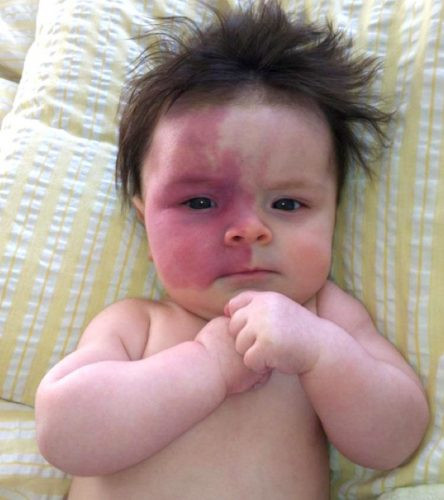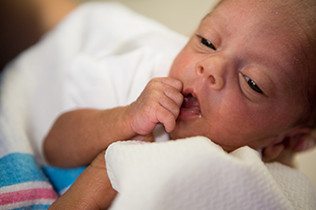Definisi
Malformasi vaskular adalah suatu perkembangan atau pembentukan pembuluh darah yang tidak normal. Kelainan ini dapat terjadi pada pembuluh nadi (arteri), pembuluh darah balik (vena), pembuluh limfatik 'getah bening', pembuluh darah kapiler, atau kombinasi dari beberapa pembuluh darah.
Malformasi Limfatik
Malformasi limfatik biasanya tampak sebagai suatu benjolan/massa (pertumbuhan yang tidak normal) seperti gumpalan yang membentuk kantong (kista) yang tumbuh tidak teratur. Pembuluh limfatik lebih dikenal sebagai pembuluh getah bening, yang berisi cairan getah bening dan sel darah putih. Cairan limfe berfungsi dalam sistem pertahanan tubuh, seperti melawan bakteri atau kuman yang masuk ke dalam tubuh. Massa pada malformasi limfatik bersifat jinak, dan bukan termasuk suatu kanker.
Malformasi Kapiler
Malformasi kapiler merupakan kelainan pertumbuhan pada pembuluh darah terkecil (yang disebut kapiler) yang mengalami pelebaran di kulit. Gangguan ini tampak sebagai perubahan warna menjadi merah muda, merah, atau ungu pada kulit. Malformasi kapiler diperkirakan terjadi pada 1 dari 300 bayi baru lahir, dan seringkali dianggap sebagai “tanda lahir” yang dapat tumbuh perlahan seiring bertambahnya usia.
Malformasi Vaskular Kombinasi
Malformasi vaskular kombinasi merupakan kelainan pertumbuhan yang melibatkan dua atau lebih jenis pembuluh darah, baik pembuluh nadi, vena, kapiler, atau pembuluh limfatik. Kebanyakan malformasi kombinasi terjadi pada lengan atau kaki, namun pada dasarnya dapat terjadi pada area tubuh mana saja.
Penyebab
Malformasi Limfatik
Penyebab pasti timbulnya malformasi limfatik belum diketahui. Kelainan ini merupakan penyakit bawaan lahir yang terbentuk pada awal masa kehamilan. Saat proses pembentukannya, pembuluh limfatik mungkin tersumbat dan membesar sehingga dapat menyebabkan cairan limfatik menumpuk. Kebanyakan kasus malformasi limfatik dianggap terjadi secara acak selama perkembangan bayi di dalam rahim. Beberapa kasus malformasi limfatik diduga berhubungan dengan adanya mutasi genetik. Akan tetapi, mutasi tersebut juga dianggap terjadi secara acak dan tidak diwariskan dalam keluarga.
Malformasi Kapiler
Malformasi kapiler diduga disebabkan oleh kelainan genetik dan sering bersifat familial (diwariskan dalam keluarga). Malformasi ini terjadi saat anak Anda masih dalam kandungan, di mana pembuluh darah kapiler mengembang dan melebar sehingga memungkinkan lebih banyak darah dari jumlah normal, mengalir melaluinya dan memberikan warma merah pada kulit.
Malformasi vaskular kombinasi juga dikaitkan dengan adanya kelainan genetik dan pada beberapa kasus dapat diwariskan dalam keluarga.
Faktor Risiko
Risiko terjadinya malformasi vaskular, seperti malformasi pembuluh limfatik, kapiler, atau kombinasi, akan meningkat jika bayi lahir dari ibu yang berusia lebih tua. Bayi dengan kelainan kromosom tertentu juga akan memiliki risiko yang lebih tinggi, seperti pada sindrom Down, sindrom Turner, dan sindrom Noonan.
Gejala
Malformasi Limfatik
Sebagian besar gejala malformasi pembuluh limfatik dapat timbul dan dilihat sejak bayi lahir. Jika gejala belum timbul saat lahir, gejala mungkin akan mulai muncul sebelum bayi berusia 2 tahun. Gejala dapat bervariasi pada setiap anak tergantung pada ukuran malformasi dan di mana letak terjadinya pada tubuh. Gejala yang mungkin timbul mencakup:
- Benjolan atau massa yang lembut dan halus. Benjolan ini paling sering terjadi di leher, tetapi bisa juga muncul di kepala, mulut, lidah, mata, dada, perut, lengan, kaki, atau skrotum (kantong buah zakar) dan penis anak Anda.
- Benjolan atau massa yang membesar dengan cepat. Hal ini mungkin karena adanya perdarahan atau infeksi.
- Tanda-tanda infeksi, seperti kemerahan, rasa hangat ketika diraba, nyeri, pembengkakan, perdarahan, dan gangguan aliran pada pembuluh limfatik.
- Malformasi di dada dapat menyebabkan kesulitan bernapas dan menelan.
- Malformasi pada mata dapat menyebabkan kesulitan melihat.
Malformasi Kapiler
Gejala malformasi kapiler dapat berbeda sesuai dengan jenisnya, yaitu:
- Naevus simpleks, yang biasanya tampak sebagai bercak kecil dengan permukaan datar pada kulit yang berwarna merah muda atau merah dengan batas yang tidak jelas. Jenis ini umumnya ditemukan di tengkuk (disebut juga stork bite, eritema nuchae), di dahi di antara alis (disebut juga angel’s kiss) atau di kelopak mata. Malformasi ini akan tampak lebih jelas ketika anak menangis.
- Port-wine stain, yang biasanya berupa bercak datar besar berwarna ungu atau merah tua dengan batas yang tegas. Saat lahir, permukaan bercak biasanya datar, tetapi lama-kelamaan akan berubah menjadi bergelombang. Daerah wajah menjadi lokasi yang paling sering terkena meskipun bercak bisa terjadi di bagian tubuh mana saja.
Malformasi Vaskular Kombinasi
Gejala malformasi vaskular kombinasi dapat berupa gabungan dari beberapa gejala malformasi vaskular lainnya. Kondisi ini juga seringkali muncul sebagai kumpulan gejala (sindrom), seperti:
- Klippel-Trenaunay Syndrome (KTS), jika terdapat dua dari tiga kriteria, yaitu port-wine stain, pertumbuhan berlebih tulang dan/atau jaringan lunak, dan malformasi pembuluh vena/limfatik aliran lambat. Malformasi pembuluh vena pada KTS bisa sangat luas dan melibatkan tulang, sendi dan otot, serta kulit dan lemak yang mendasarinya.
- Sindrom Parkes-Weber, yang sangat mirip dengan KTS, tetapi pada sindrom ini melibatkan malformasi arteriovenosa aliran tinggi pada lengan atau kaki.
- Blue Rubber Bleb Nevus Syndrome, atau yang juga dikenal sebagai Sindrom Bean, mengacu pada adanya beberapa malformasi pembuluh vena aliran lambat pada kulit dan jaringan di bawahnya, serta di usus dan organ dalam lainnya.
- CLOVES (Congenital Lipomatous Overgrowth, Vascular Malformations, Epidermal Nevi and Spine Deformities), yaitu kondisi yang memengaruhi bayi dan anak kecil di mana terjadi pertumbuhan jaringan lemak yang berlebihan di seluruh tubuh. Gangguan ini biasanya terjadi pada tubuh, kaki, lengan, kepala, atau leher. Beberapa anak memiliki ruam merah tua (keunguan) yang terlihat seperti port-wine stain. Penderita CLOVES juga mungkin memiliki kelainan bentuk tulang belakang seperti skoliosis dan malformasi arteriovenosa aliran tinggi yang memengaruhi sumsum tulang belakang.
- Hereditary Hemorrhagic Telangiectasias (HHT), atau dikenal juga sebagai Osler-Webe-Rendu Syndrome, yaitu suatu kondisi yang diwariskan oleh orang tua kepada anak-anak yang ditandai dengan malformasi pada pembuluh nadi kecil. Gejalanya meliputi mimisan dan munculnya ruam kulit, terutama pada telapak tangan dan kaki.
Diagnosis
Dalam mendiagnosis malformasi vaskular pada pembuluh limfatik, kapiler, atau kombinasi, dokter akan mulai dengan melakukan wawancara dengan orang tua atau pengasuh anak. Dokter akan menanyakan gejala-gejala apa saja yang dialami, sejak kapan gejala timbul, riwayat kondisi bayi saat lahir, serta riwayat kesehatan anak lainnya. Selanjutnya dokter akan melakukan pemeriksaan fisik dengan melihat langsung area tubuh yang terkena. Dokter juga mungkin meraba permukaan area kulit yang terkena. Pada dasarnya, diagnosis malformasi vaskular pada pembuluh limfatik, kapiler, atau kombinasi dapat ditegakkan berdasarkan temuan klinis dari hasil wawancara dan pemeriksaan fisik. Namun, untuk lebih memastikan diagnosis dan jenis pembuluh darah yang terkena, dokter mungkin akan melakukan pemeriksaan penunjang, seperti pemeriksaan USG, rontgent X-ray, CT-scan atau CT angiography (pemeriksaan CT-scan pada pembuluh darah), dan MRI.
Tata Laksana
Malformasi Limfatik
Pengobatan dan terapi malformasi pembuluh limfatik akan tergantung pada gejala, usia, kesehatan umum anak, dan seberapa parah kondisinya. Beberapa pilihannya, antara lain:
- Observasi, di mana dokter akan menunggu dan mengawasi perkembangan malformasi tanpa pengobatan khusus. Dokter akan mengawasi tanda-tanda infeksi, perdarahan, atau peningkatan ukuran
- Obat-obatan, seperti pemberian antibiotik jika mengalami infeksi.
- Pembedahan, untuk memotong massa atau benjolan yang timbul.
- Skleroterapi, dengan memberikan suntikan khusus ke dalam massa untuk menghancurkannya.
- Terapi laser atau radiofrequency ablation, untuk menghancurkan massa dengan laser atau gelombang radio.
Malformasi Kapiler
Malformasi kapiler biasanya diobati dengan terapi laser, seperti pulse dye laser, yang menargetkan langsung pembuluh darah kapiler di kulit.
Malformasi Vaskular Kombinasi
Tatalaksana malformasi vaskular kombinasi mungkin memerlukan berbagai macam gabungan terapi, seperti:
- Embolisasi, yaitu suatu prosedur untuk menutup pembuluh darah abnormal dari dalam menggunakan suatu “lem” atau partikel khusus.
- Terapi laser
- Skleroterapi
- Pembedahan
- Obat-obatan
Komplikasi
Malformasi Limfatik
Malformasi pembuluh limfatik yang tidak diobati dapat menyebabkan komplikasi yang bervariasi tergantung ukuran dan lokasi terjadinya. Beberapa di antaranya, mencakup:
- Malformasi besar di leher atau dada dapat mengganggu pernapasan dan menelan sehingga bisa mengancam jiwa.
- Perdarahan
- Infeksi
- Kelainan bentuk jaringan lunak dan tulang
- Tindakan pembedahan dapat membahayakan jaringan di dekatnya atau menyebabkan perdarahan.
Malformasi Kapiler
Malformasi pembuluh darah kapiler jarang menimbulkan komplikasi yang serius. Malformasi jenis ini lebih sering menimbulkan masalah estetik pada penderitanya.
Malformasi Vaskular Kombinasi
Komplikasi malformasi vaskular akan bervariasi tergantung dari jenisnya. Komplikasi cenderung lebih sering terjadi ketika ukurannya besar dan banyak jenis pembuluh darah yang terlibat.
Pencegahan
Malformasi vaskular pada pembuluh limfatik, kapiler, atau kombinasi merupakan kelainan bawaan lahir dan sering berhubungan dengan mutasi genetik sehingga belum diketahui cara pasti untuk mencegahnya.
Kapan Harus ke Dokter
Konsultasikan anak Anda ke dokter jika memiliki gejala-gejala malformasi vaskular. Dokter akan membantu dalam menentukan diagnosis dan tatalaksana yang tepat.
Mau tahu informasi seputar penyakit lainnya? Cek di sini, ya!
- dr Anita Larasati Priyono
Capillary Malformation. Retrieved 24 April 2022, from https://www.childrenshospital.org/conditions/capillary-malformation
Capillary Malformation. Retrieved 24 April 2022, from https://www.hopkinsmedicine.org/health/conditions-and-diseases/capillary-malformation#
Johnson, Craig M. Lymphatic Malformations. Retrieved 24 April 2022, from https://kidshealth.org/en/parents/lymphatic-malformations.html#
Lymphatic Malformation (Cystic Hygroma, Lymphagioma). Retrieved 24 April 2022, from https://www.rch.org.au/plastic/department_sections/Lymphatic-malformation/
Lymphatic Malformations in Children. Retrieved 24 April 2022, from https://www.stanfordchildrens.org/en/topic/default?id=lymphatic-malformations-90-P02045
Oakley, Amanda. Capillary Vascular Malformation. Retrieved 24 April 2022, from https://dermnetnz.org/topics/capillary-vascular-malformation
Ricci, Kiersten. Combined Vascular Malformation. (2020). Retrieved 24 April 2022, from https://www.cincinnatichildrens.org/health/c/combined
Vascular Malformations. Retrieved 24 April 2022, from https://www.med.unc.edu/vascularanomaliesclinic/patient-and-family-resources-1/what-we-treat-1/vascular-malformations/
Vascular Malformations. Retrieved 24 April 2022, from https://www.yalemedicine.org/conditions/vascular-malformations











